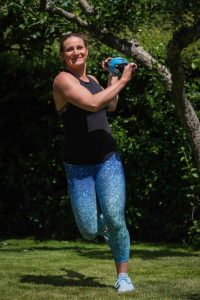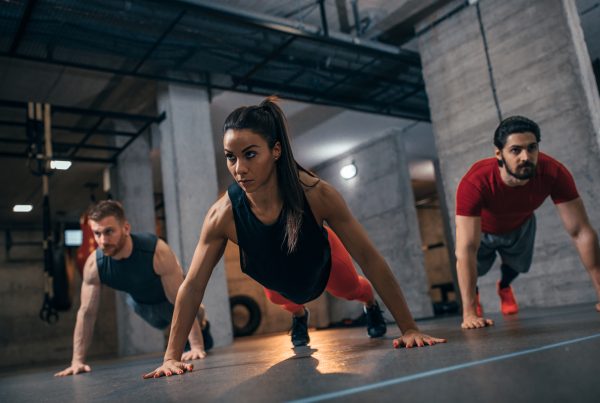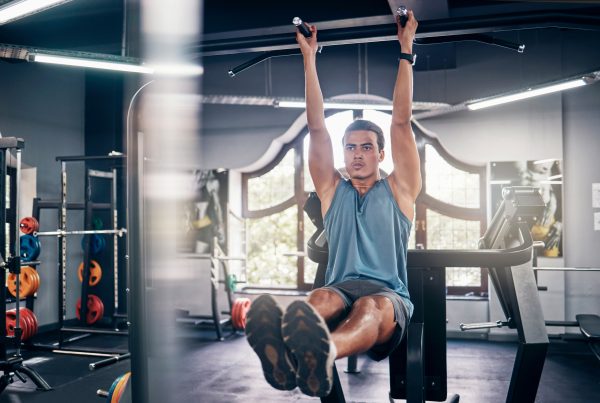Here is the third of Ally Taylor’s movement mastery series – this time it’s all about that peach. And yes, Ally has included another jam-packed video for you to truly activate your assets.
“Before you do your squats, make sure you ‘activate’ your glutes by performing some small-range movements that give your bum a really good burn, otherwise they won’t ‘switch on’!”
“Before you catch that child as they leap off a climbing frame, it’s critical to ‘activate’ the muscles involved in catching said child!”
If the second statement sounds ridiculous, then why doesn’t the first? Our bodies are designed to move by sending an impulse from the brain to a muscle via a nerve and motor unit. The truth is your body will recruit all the necessary muscles to complete the task being asked of it. This might consist of recruiting low threshold motor units for some tasks such as walking, slow jogging or lifting light weights. Or it might be high threshold motor units for sprinting, heavy lifting or catching the child from the climbing frame. We cannot consciously choose what we recruit and at what level when moving in day-to-day life. If I reach my arm out to grasp the wine glass you are offering me, I cannot ask my biceps not to get involved.
So why on earth do we insist on making up terms like dormant butt syndrome and lazy glutes, or wrap a band around our client’s thighs and ask them to produce minute burning movements? Are these things helpful to our client?
Perhaps the question we should be asking is not whether “my muscles are activated” but “am I able to recruit their full potential?”
Light up, light up
Let’s dig into the science.
Every muscle is innervated by a nerve, which runs from the brain via the spinal cord. Low level movement stimulates your low threshold motor units. Higher intensity movement, such as sprinting or heavier lifting, recruits your high threshold motor units. We also know that the majority of motor units are recruited at loads as low as 33% of their maximum potential.
When working out at a lower intensity, you will begin to recruit more of your higher threshold motor units as you fatigue and the neuromuscular system attempts to sustain the levels of force necessary to continue work output during repeated contractions, even at lower speeds and weights. So, we are recruiting our motor units any time we begin moving, which is lucky as otherwise you’d have to warm up and do special prep before sprinting for that train!
This recruitment of motor units happens more effectively in trained people than untrained people. Studies show that neural drive can increase by several percent after just six weeks of training in untrained populations. Early phase adaptations to a newly started exercise programme are primarily related to neural improvements. Simply exercising more means your muscles will ‘activate’ much better when you ask them to, even in everyday life. We could probably call that better ‘recruitment’, which is less snazzy and might sell fewer techniques!
But how do I ensure I am reaching my full potential if I am not new to training?
Our bodies are designed to move three dimensionally. The more we move in different planes of motion, the more we stimulate the different proprioceptors that reside in our various tissues. We have many proprioceptors and they all have different roles, but collectively we could consider them as multicoloured Christmas tree lights. When you switch them all on, your tree looks awesome. Stimulating all your proprioceptors increases neural drive to muscles. This leads to increased fibre recruitment, which subsequently leads to greater movement fluency and congruency as well as improved outcomes in hypertrophy/strength/endurance. Simply put, you move better so you can start to lift heavier, run faster, move more skilfully, etc. with a reduced risk of random injury.
So, how do we get our proprioceptors to light up?
Let’s take a mini dive into seven of the key proprioceptors.
- Golgi-Mazzoni corpuscles
This high threshold proprioceptor resides in articular joint tissue and the cartilaginous labrum tissue of the hip and shoulder. It is the only proprioceptor which likes to be contracted and is stimulated via strong compression of the joint.
- Pacinian corpuscles
These low threshold proprioceptors live in joint capsules at the distal end. They don’t need a lot of force or movement to be switched on, but they do get bored easily and switch back off, so changing speeds and complexity of movement keeps them lit up. Pacinian corpuscles, along with the rest of the proprioceptors listed, are switched on in extension, which does rather make you reconsider a glute bridge for activating anything other than your fatigue management system!
- Golgi ligament endings
These hang out in the ligaments where the nerve goes to a nearby muscle. They love movement in all three planes and they don’t need to be at end range to turn on.
- Ruffini endings
These reside in joint capsules at the proximal end as well as in the spine. They are highly sensitive to the transverse plane and they like to speed up. They are best stimulated at end range, speeding up and slowing down.
- Golgi tendon organs (GTOs)
As the name suggests, these live in the tendons and, in combination with other proprioceptors, wake up best when used in frontal and transverse plane movement combined at end range. Are you sensing a theme yet?
- Muscle spindle proprioceptors
These live in the muscle spindle and they guide shortening and lengthening. They love to be stimulated in all three planes of motion at once at end range.
- Fascial proprioceptors
These are some of the least understood proprioceptors. What we do know is there are several types and they need to be worked in all three planes simultaneously by winding up various joints across a movement.
That’s a lot of proprioceptors to think about, but don’t worry. Although I’ve given you example exercises for each one in the video, essentially you can train all of them simultaneously with movements in all three planes at, or near, end range and tweaking some speeds.
Isn’t end range where people get injured?
End range means taking a joint/muscle to its available end point – the point where we might consider ourselves most vulnerable to injury, especially if we had to get into the position quickly, with high velocity or with a lot more weight than we are accustomed to. When we train a joint near or at its limit in a thoughtful, careful and progressive way, we increase our functional strength and resilience in the tissue. When we require that range suddenly, we do not throw our proprioceptors into chaos as they are used to going there. We shouldn’t avoid end range or be afraid of it, as to do so reduces our body’s ability to move well and withstand the demands of day-to-day life, which includes sudden extreme movement.
Baby got backside
Let’s switch gears to finish and talk about the other element to this: gaining a nice peachy behind. Many an influencer video with a Kim Kardashian-esque behind is shown kneeling with a booty band strapped around their upper legs, performing some sort of peeing dog kick to the side or ‘Call on Me’ hip thruster-esque exercise to perfect their derriere. Booty bands are literally everywhere on social media as a way of achieving this sought-after shaping. But what does the science say about how a muscle hypertrophies or grows?
- Maximal muscle development requires training a muscle through its complete range of motion in all planes.This is because muscles are recruited differentially throughout the range of motion. Simply put, different fibres switch on at different points and we need all of them to have been stimulated for growth.
- Evidence also suggests that when training at longer muscle lengths, the greatest point of stretch actually promotes greater hypertrophic adaptation than training at shorter muscle lengths. End range training elicits growth of the muscle in series rather than in parallel – think adding muscle longways (like a gymnast) rather than width (like a bodybuilder) so you end up lean and defined.
- In EMG studies, the exercises with the highest recruitment of glute medius and glute maximus are single-leg standing variations.
- Growing muscle and, therefore, a peachy behind also requires the right genetics, nutrition and patience. Growing muscle means you need to spend a decent chunk of time at the gym, as you need to do enough overall volume with enough variety to elicit the various chemical responses which need to happen. Stress, poor nutrition and the wrong choice of parents will all affect your ability to grow glutes, or any muscle.
- When we train small range of motion with bands, we are training almost isometrically. This elicits a high level of fatigue and lactic acid FAST. This burn makes us feel like it’s effective. As I mentioned on the Core for Life blog, burn does not equal effective. If only it were that simple. Small range of motion is highly appropriate after surgery or an injury when you need to protect an area during rehab and bands could be a part of that rehab early on, but for growth …? Nope! To use a well-worn phrase, it’s just fake news!
So, throw away your booty band, get up off the floor and move your body the way nature intended. That’s multi-directionally, through full range of motion, with as much variation as you can throw at it. Your body will not only look better, but it will also move better and thank you for it too!
Want to learn more from Ally? Check out another of her mastery sessions. This time Ally looks at the squat – check out Movement Mastery – The Squat

Ally Taylor has been a personal trainer and group exercise instructor for over 21 years and runs a private studio in East Horsley, Surrey. She specialises in training the human being, not just the human body and believes we need more focus on movement for health, rather than just aesthetics. She has also worked in fitness education for over 12 years and has trained over 1000 trainee fitness instructors in that time.
REFERENCES
- Blecher R, Heinemann-Yerushalmi L, Assaraf E, Konstantin N, Chapman JR, Cope TC, Bewick GS, Banks RW, Zelzer E. New functions for the proprioceptive system in skeletal biology. Philos Trans R Soc Lond B Biol Sci. 2018 Sep 24;373(1759):20170327. doi: 10.1098/rstb.2017.0327. PMID: 30249776; PMCID: PMC6158198.
- Santuz A, Akay T. Muscle spindles and their role in maintaining robust locomotion. J Physiol. 2023 Jan;601(2):275-285. doi: 10.1113/JP282563. Epub 2022 Dec 26. PMID: 36510697.
- Ebert, J. R., Edwards, P. K., Fick, D. P., & Janes, G. C. (2017). A Systematic Review of Rehabilitation Exercises to Progressively Load the Gluteus Medius, Journal of Sport Rehabilitation, 26(5), 418-436. Retrieved May 4, 2023
- Schoenfeld BJ, Grgic J, Ogborn D, Krieger JW. Strength and Hypertrophy Adaptations Between Low- vs. High-Load Resistance Training: A Systematic Review and Meta-analysis. J Strength Cond Res. 2017 Dec;31(12):3508-3523. doi: 10.1519/JSC.0000000000002200. PMID: 28834797.
- Taylor A. Give proprioceptors a chance. Adv Exp Med Biol. 2002;508:327-34. doi: 10.1007/978-1-4615-0713-0_38. PMID: 12171127.
- Schoenfeld BJ. The mechanisms of muscle hypertrophy and their application to resistance training. J Strength Cond Res. 2010 Oct;24(10):2857-72. doi: 10.1519/JSC.0b013e3181e840f3. PMID: 20847704.
- Blumer R, Carrero-Rojas G, Calvo PM, Streicher J, de la Cruz RR, Pastor AM. Proprioceptors in extraocular muscles. Exp Physiol. 2023 Mar 3. doi: 10.1113/EP090765. Epub ahead of print. PMID: 36869596.
- Wackerhage H, Schoenfeld BJ, Hamilton DL, Lehti M, Hulmi JJ. Stimuli and sensors that initiate skeletal muscle hypertrophy following resistance exercise. J Appl Physiol (1985). 2019 Jan 1;126(1):30-43. doi: 10.1152/japplphysiol.00685.2018. Epub 2018 Oct 18. PMID: 30335577.
- Schoenfeld B. Science and Development of Muscle Hypertrophy
- grayinstitute.com/blog/proprioceptors-series-part-3-2s-tweaks-golgi-mazzoni-corpuscles







